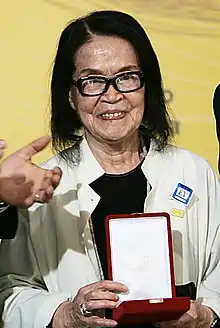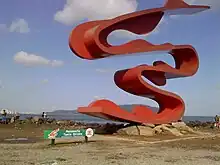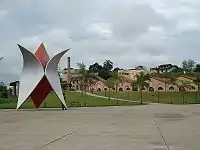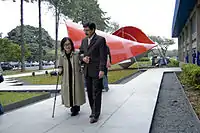Tomie Ohtake | |
|---|---|
大竹富江 | |
 Ohtake receiving the Order of Cultural Merit in 2006 | |
| Born | Tomie Nakakubo 21 November 1913 |
| Died | 12 February 2015 (aged 101) São Paulo, Brazil |
| Citizenship | Japan (until 1968) Brazil (from 1968) |
| Education | Keisuke Sugano (菅野圭介) |
| Known for | Painting, drawing, printing, sculpture |
| Style | Geometric abstraction, lyrical abstraction |
| Movement | Abstract art |
| Spouse |
Ushio Ohtake
(m. 1936, sep.) |
| Children | 2 (including Ruy) |
| Memorial(s) | Tomie Ohtake Institute |
| Japanese name | |||||||||
|---|---|---|---|---|---|---|---|---|---|
| Kanji | 大竹富江 | ||||||||
| Hiragana | おおたけ とみえ | ||||||||
| |||||||||
Tomie Ohtake (大竹富江, Ōtake Tomie, née Nakakubo (中久保); 21 November 1913 – 12 February 2015) was a Japanese Brazilian visual artist.[1] Her work includes paintings, prints and sculptures. She was one of the main representatives of informal abstractionism in Brazil.
Biography
Ohtake was born in 1913 in Kyoto. In 1936, when she was twenty-three years old, Ohtake traveled to Brazil to visit a brother but could not return to Japan due to the Pacific Theater of World War II occurring there.[2] Ohtake settled in São Paulo with her husband, her son Ruy being born there in 1938 and started painting in 1951, after a visit to the studio of the painter Keisuke Sugano.[3]
She had her first exhibition in 1957, in the Salão Nacional de Arte Moderna, and in 1961 she participated in the São Paulo Biennale.[4] In 1972 she participated in the Prints section of the Venice Biennale and in 1978 of the Tokyo Biennale. She created dozens of public space sculptures from the late eighties; her work has been featured in several cities in Brazil, but especially in the state of São Paulo.
In 1988, Ohtake was awarded the Order of Rio Branco for the public sculpture commemorating the 80th anniversary of Japanese immigration in São Paulo and in 2006 she was awarded the Order of Cultural Merit.[5]
Tomie Ohtake was the mother of architects Ruy Ohtake and Ricardo Ohtake.[6]
She died on 12 February 2015, at the age of 101. She was cremated.[7]
Ohtake's work is in the collection of the Metropolitan Museum of Art,[8] the San Francisco Museum of Modern Art,[9] and the Tate.[10]
Legacy
In 2023 her work was included in the exhibition Action, Gesture, Paint: Women Artists and Global Abstraction 1940-1970 at the Whitechapel Gallery in London.[11]
Gallery
 Monumento Tomie Ohtake in Santos (2008)
Monumento Tomie Ohtake in Santos (2008) Monumento Guaracuí (2002)
Monumento Guaracuí (2002) Sem Título (2008), Universidade de São Paulo
Sem Título (2008), Universidade de São Paulo![Tomie Ohtake's masterpiece, in front of [MAC-USP].](../I/Tomie_Ohtake_-_MAC-USP_2.JPG.webp) Tomie Ohtake's masterpiece, in front of [MAC-USP].
Tomie Ohtake's masterpiece, in front of [MAC-USP]. Tomie Ohtake Monument (2004) in Ipatinga, Minas Gerais.
Tomie Ohtake Monument (2004) in Ipatinga, Minas Gerais. Monument in honor of 80th anniversary of Japanese Immigration (2017) on 23 May Avenue, in São Paulo.
Monument in honor of 80th anniversary of Japanese Immigration (2017) on 23 May Avenue, in São Paulo.
See also
References
- ↑ Martí, Silas (February 12, 2015). "Tomie Ohtake, grande dama da arte nacional, morre aos 101 anos em SP" [Tomie Ohtake, grande dame of national art, dies aged 101 in São Paulo]. Folha de S. Paulo (in Portuguese). Retrieved February 12, 2015.
- ↑ "Tomie Ohtake". Pitoresco (in Portuguese). Retrieved February 12, 2015.
- ↑ "Ohtake, Tomie (1913)". Enciclopédia Itaú Cultural (in Portuguese). Retrieved February 12, 2015.
- ↑ "Tomie Ohtake - Arts of the Americas". Organization of American States. Retrieved April 27, 2023.
- ↑ "Tomie Ohtake (1913–2015)". Artforum. Retrieved April 27, 2023.
- ↑ "Morre a artista Tomie Ohtake, mãe dos arquitetos Ruy e Ricardo Ohtake | CAU/BR". www.caubr.gov.br. Retrieved October 21, 2016.
- ↑ Tomie Ohtake: Painter and sculptor who moved to Brazil, where she became noted for her public artworks
- ↑ "Tomie Ohtake | Untitled". The Metropolitan Museum of Art. Retrieved April 27, 2023.
- ↑ "Ohtake, Tomie". SFMOMA. Retrieved April 27, 2023.
- ↑ "'Untitled (from the series Blind Paintings)', Tomie Ohtake, 1962". Tate. Retrieved April 27, 2023.
- ↑ "Action, Gesture, Paint". Whitechapel Gallery. Retrieved April 25, 2023.